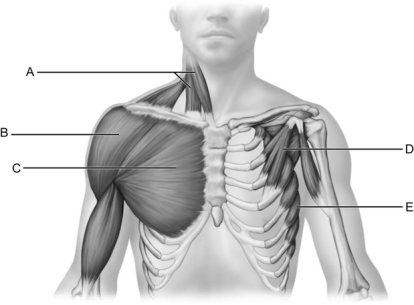A) rectus abdominis.
B) internal oblique.
C) transversus abdominis.
D) external oblique.
F) C) and D)
Correct Answer

verified
Correct Answer
verified
True/False
Intramuscular injections in the deltoid should be given about 1 inch superior to the greater tubercle.
B) False
Correct Answer

verified
Correct Answer
verified
Multiple Choice
A muscle inserting on the pisiform bone of the wrist is
A) the extensor digitorum.
B) the flexor carpi ulnaris.
C) a lumbrical.
D) the pronator teres.
F) None of the above
Correct Answer

verified
Correct Answer
verified
Multiple Choice
The sternal angle is used to locate
A) the bifurcation of the trachea.
B) rib 2.
C) the apex of the heart.
D) the cardiac sphincter of the stomach.
F) C) and D)
Correct Answer

verified
Correct Answer
verified
Multiple Choice
The latissimus dorsi originates primarily on the
A) humerus.
B) clavicle.
C) linea alba.
D) vertebral column.
F) All of the above
Correct Answer

verified
Correct Answer
verified
Multiple Choice
The major muscles used in throwing a punch are the
A) serratus anterior and triceps brachii.
B) brachioradialis and biceps brachii.
C) latissimus dorsi and deltoid.
D) teres major and brachialis.
F) A) and C)
Correct Answer

verified
Correct Answer
verified
Multiple Choice
In the neck, the hyoid bone can be felt
A) at the jugular notch.
B) where the anterior surface of the neck changes from a vertical orientation to an almost horizontal orientation.
C) at the laryngeal prominence.
D) between the thyroid cartilage and the tracheal rings.
F) A) and B)
Correct Answer

verified
Correct Answer
verified
Multiple Choice
 Figure 11.3
Use the diagram above to answer the following questions.
-Identify the letter that indicates the Serratus anterior.
Figure 11.3
Use the diagram above to answer the following questions.
-Identify the letter that indicates the Serratus anterior.
A) A
B) B
C) C
D) D
E) E
G) A) and B)
Correct Answer

verified
Correct Answer
verified
True/False
In lean, muscular individuals, the linea semilunaris marks the lateral borders of the rectus abdominis.
B) False
Correct Answer

verified
Correct Answer
verified
Multiple Choice
Which of the following statements concerning surface anatomy is false?
A) It studies internal organs as they relate to surface landmarks.
B) It is best studied in cadavers.
C) It is used to take pulses, insert tubes, make surgical incisions, and perform other clinical procedures.
D) It serves as a basis for a standard physical examination.
F) All of the above
Correct Answer

verified
Correct Answer
verified
Multiple Choice
When muscle fascicles are arranged in concentric rings this arrangement is referred to as
A) parallel.
B) bipennate.
C) convergent.
D) unipennate.
E) circular.
G) D) and E)
Correct Answer

verified
Correct Answer
verified
Multiple Choice
The Sartorius muscle, a thin straplike muscle would have muscle fascicles arranged in
A) parallel.
B) bipennate.
C) convergent.
D) unipennate.
E) circular.
G) A) and E)
Correct Answer

verified
Correct Answer
verified
Multiple Choice
The gastrocnemius operates in a -class lever system.
A) first
B) second
C) third
D) fourth
F) A) and C)
Correct Answer

verified
Correct Answer
verified
Multiple Choice
Vertical groove in the center of the back.
A) suprachristal line
B) posterior triangle
C) posterior median furrow
D) medial bicipital furrow
E) linea semilunaris
G) A) and B)
Correct Answer

verified
Correct Answer
verified
Multiple Choice
The muscle that originates on the anterior superior iliac spine is the
A) sartorius.
B) psoas major.
C) pectineus.
D) rectus femoris.
F) A) and B)
Correct Answer

verified
Correct Answer
verified
Short Answer
The psoas major and muscles are the prime movers in thigh flexion.
Correct Answer

verified
Correct Answer
verified
Essay
What muscles are important in mastication (excluding the muscles of the tongue)?
Correct Answer

verified
Masseter, temporalis...View Answer
Show Answer
Correct Answer
verified
View Answer
Multiple Choice
A dimple located two to three finger widths lateral from the midline of the back at the level of the hips is a landmark for the
A) transverse processes of the L4 vertebra.
B) anterior inferior iliac spine.
C) ischial tuberosities.
D) sacroiliac joint.
F) A) and B)
Correct Answer

verified
Correct Answer
verified
Multiple Choice
A prime mover for extending the arm at the shoulder is the
A) pectoralis major.
B) latissimus dorsi.
C) triceps brachii.
D) serratus anterior.
F) All of the above
Correct Answer

verified
Correct Answer
verified
True/False
The triangle of auscultation in the back is bordered by the latissimus dorsi, teres major, and medial border of the scapula.
B) False
Correct Answer

verified
Correct Answer
verified
Showing 101 - 120 of 201
Related Exams